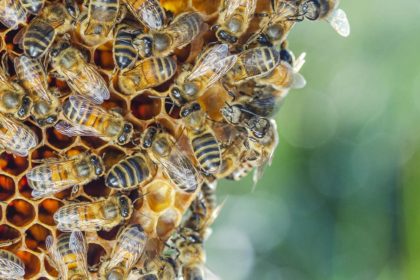
Estimated reading time: 2 minutes
A gaggle of geese, a herd of cows, a pack of wolves, a cluster of bees…. it’s all semantics.
Honeybee Cluster
What is the cluster size? This is a common question you may hear among beekeepers when discussing the size of a honey bee colony. The honeybee cluster is the main brood area of the hive. Here the queen will lay eggs and the nurse bees will feed the young. Honey and pollen will be stored nearby for ready access. The cluster area is the “heart of the hive”, especially in winter.
Most of the year, the honeybees will be spread out over the frames going  about their daily chores. But the arrival of cool weather forces the bees to begin the clustering behavior. Because of the rearing of young, the brood area must be kept warm. When brood is present the temperature at the center of the honeybee cluster will be near 94 degrees. The bees produce heat by moving their wing muscles. As you move toward the outside of the cluster the temperature will drop. When the weather gets colder, the bees cluster tighter together.
about their daily chores. But the arrival of cool weather forces the bees to begin the clustering behavior. Because of the rearing of young, the brood area must be kept warm. When brood is present the temperature at the center of the honeybee cluster will be near 94 degrees. The bees produce heat by moving their wing muscles. As you move toward the outside of the cluster the temperature will drop. When the weather gets colder, the bees cluster tighter together.
Most beekeepers want a large cluster of bees going into late Fall. Throughout the winter, some of the older bees will die and the hive population will decrease. We want a colony to have a large enough population to sustain some loss before new bees begin to appear in late winter.
Genetics also plays a part in cluster size. Some strains of bees (such as Russians or Carniolans) will carry smaller clusters into winter and then expand the brood nest rapidly upon the arrival of early Spring.
When bitter cold weather arrives, the bees will not leave the cluster to bring honey close by. If the cold weather continues until the honey supply near the cluster is exhausted – the bees will die. This is especially a danger to small clusters. So, a honeybee colony can perish even when they have a full super of honey on top or several frames away. The honey stores have to be in the right place at the right time.
We wish the very best for all of our beekeeping friends and their bees during this winter weather!
This is a great time of year to prepare new equipment for Spring. We have everything you need: order here



You must be logged in to post a comment.